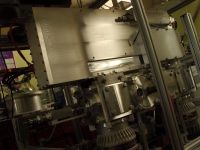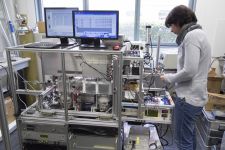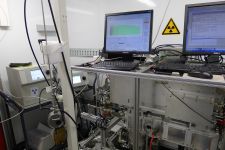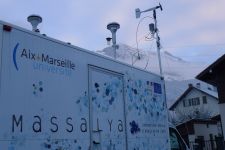
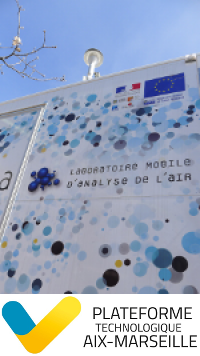 MASSALYA is a mobile laboratory dedicated to online analysis of aerosol particles and volatile organic compounds (VOC) in both indoor and outdoor environments. The mobile unit (< 3.5 tonnes) is implemented with state of the art instrumentation (PTR- ToF -MS , HR- ToF –AMS, TAG ... ). The instrumentation can be easily uninstalled from the mobile van and installed indoors for laboratory experiments.
MASSALYA is a mobile laboratory dedicated to online analysis of aerosol particles and volatile organic compounds (VOC) in both indoor and outdoor environments. The mobile unit (< 3.5 tonnes) is implemented with state of the art instrumentation (PTR- ToF -MS , HR- ToF –AMS, TAG ... ). The instrumentation can be easily uninstalled from the mobile van and installed indoors for laboratory experiments.
The MASSALYA platform relies on the scientific and technical skills of the LCE-IRA research group. Studies requested by the platform partners (research laboratories, industry and local authorities ...) can be organized and implemented in collaborations with LCE-IRA group which may , if necessary , implement additional experimental means.
Contacts
Brice Temime-Roussel (Research engineer) : (+33) 4 13 55 10 53
Henri Wortham : (+33) 4 13 55 10 39
Nicolas Marchand : (+33) 4 13 55 10 51
INSTRUMENTATION
The instrumentation of the MASSALYA platform allows the physical and the chemical characterizations of aerosol particles and volatile organic compounds (VOC). This characterization is done in nearly real time on a time scale ranging from few seconds to 30 min.
MASSALYA instrumentation :
- PTR-ToF-MS (Proton Transfert Reaction-Time of Flight-Mass Spetrometer) for the analysis of VOCs. The PTR-TOFMS technology allows to analyze a whole mass spectrum in a split second and even isobaric species can be resolved and identified with virtually no instrumental mass range limitation and a linearity range over six orders of magnitude. This instrument allows the simultaneous analysis of a large number of VOC at the ppt level. The temporal resolution can reach few seconds in some environments. It is equipped with SRI module ( Selective Ionization Reagent ) which enables the analysis through different ionization modes (ie. H3O+, O2+ and NO+) and with a fast GC [More details]
- HR-ToF-AMS (High Resolution-Time of Flight-Aerosol Mass Spectrometer, Aerodyne Research Inc.) for the analysis of organic and inorganic aerosol particles. This is the only currently available instrument capable of providing quantitative size and chemical mass loading information in real-time for non-refractory sub-micron aerosol particles. The AMS couples size-resolved particle sampling and mass spectrometric techniques into a single real-time measurement system. The High-Resolution ToF AMS (HR-ToF-AMS) also enables continuous acquisition of complete mass spectra of individual particles, and enables the resolution of distinct chemical species based on mass defect.. [More details]
- TAG for analysis of the organic fraction of the aerosol at the molecular level. The TAG is, here, associated with the HR-ToF-AMS. The combined TAG-AMS instrument shares the same electron impact ion source and HR-ToF-MS for the analysis of the atmospheric aerosol composition. While atmospheric aerosols are measured using the HR-ToF-AMS to provide mass spectral analysis of the total organic aerosol, aerosol is collected simultaneously in the integrated collection and thermal desorption (CTD) cell of the TAG instrument. The collected aerosol sample is subsequently desorbed from the CTD cell, chromatographically separated, and introduced into the AMS electron impact ionization region for analysis. The combination of hourly time resolved TAG measurements with the complementary AMS measurements provides mass spectral analysis of the total organic aerosol (AMS) and concurrent detailed molecular level analysis (TAG). TAG- AMS allows the analysis of nonpolar and slightly polar compounds such as polycyclic aromatic hydrocarbons ( PAHs ) , the hopanes / steranes , alkanes , alkenes , phthalates , some pesticides , etc. . The high sensitivity of the instrument allows a temporal resolution of approximately 1h . [More details]
A new online derivatization system using a helium flow saturated with MSTFA extended the analysis range to highly polar compounds such as secondary compounds from biogenic or anthropogenic origin and organic markers from biomass burning ( levoglucosan , manosan , methoxy phenols) . The online derivatization system is a collaborative development between Aerosol Dynamics Inc., Pr. Allen Goldstein group (Univ Berkeley, CA) and LCE.
- LAAPToF (Laser Ablation Aerosol Particle Time-of-Flight) for the analysis of the single aerosol particle. This new single particles analyser is capable of analyzing aerosol particles in the range of 70 nm to 700 nm , and provides information on both particle size and chemical signature. The LAAPToF is an instrument of the national NaNO-ID platform [More details]
- MAAP 5012 (Multi Angle Absorption Photometer) for the analysis of Black Carbon. MAAP measures the aerosol-related absorption of light and the corresponding atmospheric black carbon mass concentration. Continuous data is provided by a multiple detector setup to simultaneously measure the transmitted and the scattered light from a particle-loaded filter. Typical applications include determining ambient elemental carbon for health-related effects and aerosol light absorption for visibility monitoring (regional haze) and climate reasearch. [More details]
- SMPS (Scanning Mobility Particle Sizer) for the size distribution of submicron aerosol particles. [More details]
- Ozone analyser (O3).
- NOx analyser (NO, NO2). Based on chemiluminescence detection, this method is an extremely selective method for measuring nitrogen oxides precisely, with high linearity over a wide concentration range and with very high reproducibility. The analysers (CLD88P and PLC860) are particularly adapted to low NOx concentrations.
- Weather station (wind speed and direction, T, RH).

